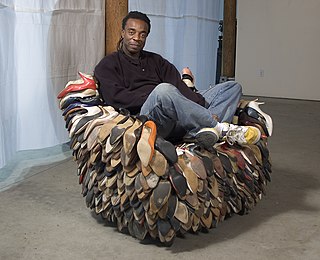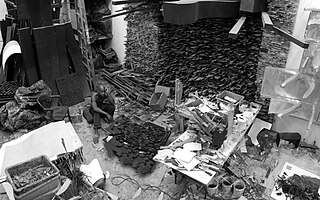Dana Schutz is an American artist who lives and works in Brooklyn, New York. Schutz is known for her gestural, figurative paintings that often take on specific subjects or narrative situations as a point of departure.
Daniel Colen is an American artist based in New York. His work consists of painted sculptures appropriating low-cultural ephemera, graffiti-inspired paintings of text executed in paint, and installations.
Peter Campus, often styled as peter campus, is an American artist and a pioneer of new media and video art, known for his interactive video installations, single-channel video works, and photography. His work is held in the collections of numerous public institutions, including The Museum of Modern Art, Whitney Museum of American Art, Solomon R. Guggenheim Museum, Hamburger Bahnhof - Museum für Gegenwart, Tate Modern, Museo Reina Sofía, Albright-Knox Art Gallery, Walker Art Center, and the Centre Georges Pompidou. The artist works on the south shore of Long Island.

The Zach Feuer Gallery was a contemporary art gallery that operated from 2000 to 2016 in New York City; Hudson, New York; and Los Angeles.
Julie Ault is an American artist, curator, and editor who was a cofounder of Group Material, a New York-based artists' collaborative that has produced over fifty exhibitions and public projects exploring relationships between politics and aesthetics. She was awarded a MacArthur Fellows Program grant, commonly referred to as a MacArthur Genius Grant, in 2018 in recognition for her achievements "redefining the role of the artwork and the artist by melding artistic, curatorial, archival, editorial, and activist practices into a new form of cultural production."
Beth Campbell is an American artist who works in drawing, sculpture, and installation.

Willie Cole is a contemporary American sculptor, printer, and conceptual and visual artist. His work uses contexts of postmodern eclecticism, and combines references and appropriation from African and African-American imagery. He also has used Dada’s readymades and Surrealism’s transformed objects, as well as icons of American pop culture or African and Asian masks.

Sharon Louden is an American visual artist, known for her abstract and whimsical use of the line. Her minimalist paintings and drawings have subsequently transformed over the years into other media, being expressed as "drawings-in-space." She has also expanded into a wide-ranging use of color. In reference to her minimalist paintings, Louden has been called "the Robert Ryman of the 21st century."

Marco Maggi is a New York- and Uruguay-based artist whose work incorporates common materials such as office paper, aluminum foil, graphite, and apples to create micro drawings, sculptures, and macro installations.

Alvin D. Loving Jr., better known as Al Loving, was an African-American abstract expressionist painter. His work is known for hard-edge abstraction, dyed fabric paintings, and large paper collages, all exploring complicated color relationships.
Ry Rocklen is a contemporary artist based in Los Angeles, working primarily in sculpture. Rocklen's solo exhibitions often make use of found objects which he adorns or otherwise modifies. From 1996 to 1998, he attended the California Institute of the Arts. Rocklen earned his BFA in 2001 at UCLA, and his MFA in sculpture in 2006 at the University of Southern California. Rocklen's work has been shown nationally and internationally, and has been included in several major survey exhibitions, including "Made in LA" at the Hammer Museum and the 2008 Whitney Biennial. He is represented by Honor Fraser gallery in Los Angeles and Praz-Delavallade in Paris/Los Angeles.
Kate Levant is an American artist.

Leonardo Drew is a contemporary artist based in Brooklyn, New York. He creates sculptures from natural materials and through processes of oxidation, burning, and decay, Drew transforms these objects into massive sculptures that critique social injustices and the cyclical nature of existence.
Elaine Reichek is a New York-based visual artist. Much of her work concerns the history of the embroidered sampler. Through her pieces of hand and machine embroidery and digital sewing machine, she addresses issues such as the craft/art and the old/new divide, the nature of women's work, and the interplay of text and image. The connection between the pixel and the stitch, as differently gendered types of mark-making, is a continuing theme in her work.
Dawn Clements (1958–2018) was an American contemporary artist and educator. She was known for her large scale, panoramic drawings of interiors that were created with many different materials in a collage-style. Her primary mediums were sumi ink and ballpoint pen on small to large scale paper panels. In order to complete a drawing she cut and pasted paper, editing and expanding the composition to achieve the desired scale. Her completed drawings reveal her working process through the wrinkles and folds evident in the paper. She described her work as "a kind of visual diary of what [she] see[s], touch[es], and desire[s]. As I move between the mundane empirical spaces of my apartment and studio, and the glamorous fictions of movies, apparently seamless environments are disturbed through ever-shifting points of view."
Sharon Harper is a contemporary visual artist, based in Cambridge, Massachusetts. Harper is interested in photography as it relates to perceptual experiences between humans and the natural environment. Harper is currently professor of Art, Film, and Visual Studies at Harvard University.

Kambui Olujimi is a New York-based visual artist working across disciplines using installation, photography, performance, tapestry, works on paper, video, large sculptures and painting. His artwork reflects on public discourse, mythology, historical narrative, social practices, exchange, mediated cultures, resilience and autonomy.
Torkwase Dyson is an interdisciplinary artist based in Beacon, New York, United States. Dyson describes the themes of her work as "architecture, infrastructure, environmental justice, and abstract drawing." Her work is informed by her own theory of Black Compositional Thought. This working term considers how spatial networks—paths, throughways, water, architecture, and geographies—are composed by Black bodies as a means of exploring potential networks for Black liberation. She is represented by Pace Gallery and Richard Gray Gallery.
Jackson Polys is a Tlingit Native visual artist and filmmaker whose work is based between Alaska and New York. His work examines the constraints and potential in the desire for Indigenous advancement, while challenging existing gazes onto traditional Native culture. Polys is well known for his films, institutional critique, and carved sculptures incorporating materials such as abalone, glass, liquids, resins, silicone, as well as the ready-made.
Jane South is a British American artist and educator known for large scale installations, mixed media constructions, and fabric wall pieces.






